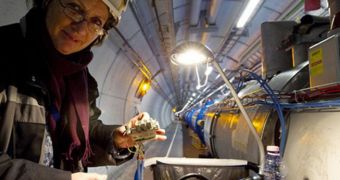Engineers operating the Large Hadron Collider (LHC), the largest particle accelerator in the world, have recently decided on the schedule they will follow for the upcoming years. They say that they will continue to run the massive scientific experiment at a low power level through 2011, after which time they will shut it down for a year, and then resume operations at maximum capacity, starting with 2013. The LHC is operated by the European Organization for Nuclear Research (CERN).
After experiencing a major glitch at the end of 2008, the accelerator was shut down for nearly a year, as experts cleaned up the helium spill, and repaired the superconducting magnets that were displaced during the incident. It was only a couple of months ago that the collider was reopened. Shortly afterwards, it exceed the world record for the most energetic collision of particles, as it started smashing protons together at energies reaching 1.18 TeV per beam, considerably higher than the Tevatron's 0.98 TeV per beam. The previous record had been held for eight consecutive years.
At this point, the LHC is being prepared to start again, after it was shut down for a few weeks, during the holiday season. It will resume basic operations, and collisions will again take place in its four particle detectors. Its energy level is scheduled to be ramped up to 3.5 TeV per beam, for a total power output of 7 TeV. It will continue to operate at these levels throughout 2010 and 2011. At the end of the next year, it will be shut down again, this time to conduct upgrade work and preparations.
Once the year of maintenance is over, the accelerator will be again turned on in early 2013, but this time at its highest energy output, of 7 TeV per beam, or 14 TeV in total. Physicists estimate that one Higgs boson will be produced at this rate every hour, which means that two or three more years will have to pass before conclusive data is gathered to confirm or infirm its existence. An additional year or so will pass until experts will be able to tell if any sign of supersymmetry has been made available following the highly energetic collisions, NewScientist reports.

 14 DAY TRIAL //
14 DAY TRIAL //